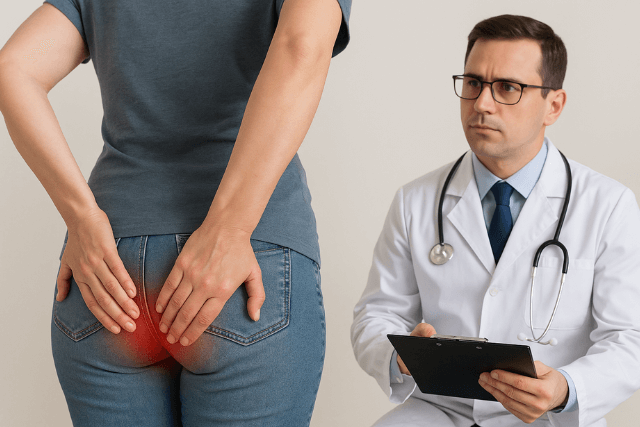Many people experience hemorrhoids during their lifetime. Thankfully, this condition is often preventable. By learning about the causes of hemorrhoids, you can take important steps to avoid them. This blog will guide you through every essential detail in a clear and practical way.
Understanding Hemorrhoids
Hemorrhoids are swollen veins located in the lower rectum or anus. They result from increased pressure on these veins. When the veins swell, they can cause pain, itching, or bleeding. Internal hemorrhoids form inside the rectum. External hemorrhoids develop under the skin near the anus. Knowing these types helps you identify the condition early. Most importantly, it sets the stage for effective prevention.
Primary Causes of Hemorrhoids
The main causes of hemorrhoids involve too much pressure in the rectal area. This pressure can come from straining during bowel movements. It can also result from prolonged sitting or pregnancy. While these causes vary, the outcome is often the same. Veins swell, become irritated, and eventually form hemorrhoids. Understanding this process helps you avoid the root problem.
Risk Factors You Should Know
Certain factors make some people more likely to develop hemorrhoids. A family history of the condition increases your risk. Being in a higher weight body or maintaining a sedentary lifestyle also increases your risk. Even lifting heavy items too often may raise your chances. Recognizing these risk factors helps you make informed lifestyle choices.
Poor Diet and Hemorrhoid Development
A low-fiber diet is one of the key causes of hemorrhoids. Without enough fiber, stools become hard. Passing hard stools leads to straining, which puts stress on your veins. You can prevent this by eating fiber-rich foods. These include fruits, vegetables, beans, and whole grains. Making simple diet changes can offer long-term relief.
Constipation and Hemorrhoid Flare-ups
Constipation causes you to strain, and straining leads directly to hemorrhoids. When bowel movements become infrequent, stools dry out and harden. As a result, you push harder during elimination. This excessive pressure swells the veins. Drinking water, moving more, and eating fiber help prevent constipation.
Pregnancy and Hemorrhoid Risk
During pregnancy, the uterus puts pressure on veins in the pelvic area. This pressure slows blood flow. Hormonal changes also relax blood vessels. Together, these factors cause veins to swell. Many pregnant people experience hemorrhoids in the third trimester. Fortunately, staying hydrated and eating well help minimize this risk.
Aging and Hemorrhoid Vulnerability
Aging makes you more prone to hemorrhoids. Over time, tissues in the rectum and anus weaken. Veins lose elasticity, which increases the chance of swelling. Additionally, older adults may move less and eat fewer fiber-rich foods. Staying active and improving your diet are important steps for prevention.
Prolonged Sitting or Standing
Sitting or standing for long hours causes blood to pool in the lower body. This buildup puts added pressure on rectal veins. Office workers, drivers, and people with desk jobs are especially at risk. Taking frequent breaks to move around improves circulation and reduces strain.
Straining During Bowel Movements
Straining is one of the most avoidable causes of hemorrhoids. It typically happens when people force bowel movements. This can be due to poor diet or waiting too long to go. To prevent straining, go when the urge comes. Also, relax and avoid pushing too hard.
Obesity and Increased Rectal Pressure
Excess weight adds pressure to the pelvic and rectal areas. This constant strain enlarges the veins and leads to hemorrhoids. Many people in higher weight bodies also experience challenges with digestion. That makes hemorrhoids even more likely. Maintaining a healthy weight through diet and movement is a strong preventative tool.
Sedentary Lifestyle and Circulation
Lack of movement reduces blood flow and weakens digestion. As a result, veins become more prone to swelling. A sedentary lifestyle also increases the chance of constipation. Simple actions like standing up, walking, or stretching during the day help a lot. These changes keep the body active and veins healthy.
Genetics and Hemorrhoid Predisposition
If your parents or close relatives had hemorrhoids, you might too. This is due to inherited traits like weak vein walls or slow digestion. While you can’t change your genes, you can change your habits. Eating well, staying active, and avoiding strain will help reduce your risk.
How to Prevent Hemorrhoids
Prevention depends on daily habits. Drink plenty of water. Eat foods high in fiber. Avoid prolonged sitting. Use the bathroom as soon as you feel the urge. All these tips reduce the common causes of hemorrhoids. Over time, small steps create lasting health benefits.
Healthy Bowel Habits
Good habits make a big difference. Never ignore the urge to go. Don’t rush or sit too long on the toilet. Use a footstool to raise your knees. This position relaxes the rectum. It makes elimination easier and reduces the chance of strain.
Fiber-Rich Diet Tips
Fiber keeps stools soft and easy to pass. Aim for 25 to 30 grams daily. Add fruits, vegetables, beans, oats, and nuts to your meals. If you’re not used to fiber, increase it gradually. Drink more water too, so the fiber works properly.
Exercise and Blood Flow
Exercise supports healthy digestion and improves circulation. Even 20 minutes of walking each day can help. Physical activity also helps manage weight. All these effects lower your risk of hemorrhoids. So, make movement a regular part of your life.
When to See a Doctor
If you see blood in your stool or feel sharp pain, talk to your doctor. Not all rectal bleeding comes from hemorrhoids. A doctor can provide a correct diagnosis. They will also guide you on safe treatments. Early care leads to quicker healing.
Hemorrhoid Relief Options
There are many treatment options available. For example, over-the-counter creams can ease itching and pain. In addition, warm sitz baths can help soothe the affected area. However, in more serious cases, medical procedures may be necessary. These may include banding or infrared treatments. Ultimately, a doctor will choose the best option based on your symptoms.
LHP, or Laser Hemorrhoidoplasty, is a minimally invasive procedure that treats hemorrhoids using laser energy to shrink and coagulate the hemorrhoidal tissue. Compared to traditional surgical methods, it offers a gentler approach, with the added benefit of potentially reduced pain and recovery time.
Final Thoughts
Knowing the causes of hemorrhoids helps you avoid them. Simple changes in diet, movement, and habits can make a big impact. If symptoms do arise, don’t ignore them. With the right care, you can find relief and prevent future issues.










